
SOCS (suppressor of cytokine signaling proteins) refers to a family of genes involved in inhibiting the JAK-STAT signaling pathway.

SOCS (suppressor of cytokine signaling proteins) refers to a family of genes involved in inhibiting the JAK-STAT signaling pathway.
All SOCS have certain structures in common. This includes a varying N-terminal domain involved in protein-protein interactions, a central SH2 domain, which can bind to molecules that have been phosphorylated by tyrosine kinases, and a SOCS box located at the C-terminal that enables recruitment of E3 ligases and ubiquitin signaling molecules. [1]
The first protein to be classified as a suppressor of cytokine signaling, CIS (cytokine-inducible SH2), was discovered in 1995, when it was found to have a unique ability to regulate cytokine signal transduction. [2]
SOCS are negative regulators of the JAK-STAT signaling pathway. SOCS have also been implicated in the regulation of cytokines, growth factors, and tumor suppression. [3]
It has been suggested that SOCS can help prevent cytokine-mediated apoptosis in diabetes through negative regulation of pro-inflammatory cytokines secreted by immune cells, such as IFNγ, TNFα and IL-15. Improper functioning of one specific SOCS, SOCS3 may lead to type 2 diabetes, as it has been found that SOCS3 plays an important role in proper leptin signaling. [4]
Janus kinase (JAK) is a family of intracellular, non-receptor tyrosine kinases that transduce cytokine-mediated signals via the JAK-STAT pathway. They were initially named "just another kinase" 1 and 2, but were ultimately published as "Janus kinase". The name is taken from the two-faced Roman god of beginnings, endings and duality, Janus, because the JAKs possess two near-identical phosphate-transferring domains. One domain exhibits the kinase activity, while the other negatively regulates the kinase activity of the first.

Paracrine signaling is a form of cell signaling, a type of cellular communication in which a cell produces a signal to induce changes in nearby cells, altering the behaviour of those cells. Signaling molecules known as paracrine factors diffuse over a relatively short distance, as opposed to cell signaling by endocrine factors, hormones which travel considerably longer distances via the circulatory system; juxtacrine interactions; and autocrine signaling. Cells that produce paracrine factors secrete them into the immediate extracellular environment. Factors then travel to nearby cells in which the gradient of factor received determines the outcome. However, the exact distance that paracrine factors can travel is not certain.
The JAK-STAT signaling pathway is a chain of interactions between proteins in a cell, and is involved in processes such as immunity, cell division, cell death, and tumour formation. The pathway communicates information from chemical signals outside of a cell to the cell nucleus, resulting in the activation of genes through the process of transcription. There are three key parts of JAK-STAT signalling: Janus kinases (JAKs), signal transducer and activator of transcription proteins (STATs), and receptors. Disrupted JAK-STAT signalling may lead to a variety of diseases, such as skin conditions, cancers, and disorders affecting the immune system.
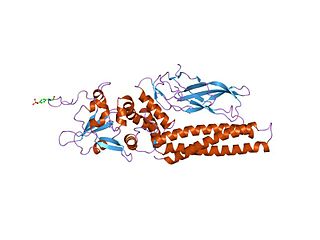
Members of the signal transducer and activator of transcription (STAT) protein family are intracellular transcription factors that mediate many aspects of cellular immunity, proliferation, apoptosis and differentiation. They are primarily activated by membrane receptor-associated Janus kinases (JAK). Dysregulation of this pathway is frequently observed in primary tumors and leads to increased angiogenesis which enhances the survival of tumors and immunosuppression. Gene knockout studies have provided evidence that STAT proteins are involved in the development and function of the immune system and play a role in maintaining immune tolerance and tumor surveillance.

Receptor tyrosine kinases (RTKs) are the high-affinity cell surface receptors for many polypeptide growth factors, cytokines, and hormones. Of the 90 unique tyrosine kinase genes identified in the human genome, 58 encode receptor tyrosine kinase proteins. Receptor tyrosine kinases have been shown not only to be key regulators of normal cellular processes but also to have a critical role in the development and progression of many types of cancer. Mutations in receptor tyrosine kinases lead to activation of a series of signalling cascades which have numerous effects on protein expression. Receptor tyrosine kinases are part of the larger family of protein tyrosine kinases, encompassing the receptor tyrosine kinase proteins which contain a transmembrane domain, as well as the non-receptor tyrosine kinases which do not possess transmembrane domains.
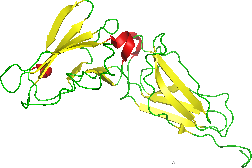
The interferon-α/β receptor (IFNAR) is a virtually ubiquitous membrane receptor which binds endogenous type I interferon (IFN) cytokines. Endogenous human type I IFNs include many subtypes, such as interferons-α, -β, -ε, -κ, -ω, and -ζ.
Vitamin A receptor, Stimulated by retinoic acid 6 or STRA6 protein was originally discovered as a transmembrane cell-surface receptor for retinol-binding protein. STRA6 is unique as it functions both as a membrane transporter and a cell surface receptor, particularly as a cytokine receptor. In fact, STRA6 may be the first of a whole new class of proteins that might be known as "cytokine signaling transporters." STRA6 is primarily known as the receptor for retinol binding protein and for its relevance in the transport of retinol to specific sites such as the eye. It does this through the removal of retinol (ROH) from the holo-Retinol Binding Protein (RBP) and transports it into the cell to be metabolized into retinoids and/or kept as a retinylester. As a receptor, after holo-RBP is bound, STRA6 activates the JAK/STAT pathway, resulting in the activation of transcription factor, STAT5. These two functions—retinol transporter and cytokine receptor—while using different pathways, are processes that depend on each other.

Signal transducer and activator of transcription 5 (STAT5) refers to two highly related proteins, STAT5A and STAT5B, which are part of the seven-membered STAT family of proteins. Though STAT5A and STAT5B are encoded by separate genes, the proteins are 90% identical at the amino acid level. STAT5 proteins are involved in cytosolic signalling and in mediating the expression of specific genes. Aberrant STAT5 activity has been shown to be closely connected to a wide range of human cancers, and silencing this aberrant activity is an area of active research in medicinal chemistry.

GRB2-associated-binding protein 2 also known as GAB2 is a protein that in humans is encoded by the GAB2 gene.
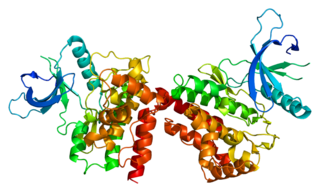
Janus kinase 2 is a non-receptor tyrosine kinase. It is a member of the Janus kinase family and has been implicated in signaling by members of the type II cytokine receptor family, the GM-CSF receptor family, the gp130 receptor family, and the single chain receptors.

Signal transducer and activator of transcription 4 (STAT4) is a transcription factor belonging to the STAT protein family, composed of STAT1, STAT2, STAT3, STAT5A, STAT5B, STAT6. STAT proteins are key activators of gene transcription which bind to DNA in response to cytokine gradient. STAT proteins are a common part of Janus kinase (JAK)- signalling pathways, activated by cytokines.STAT4 is required for the development of Th1 cells from naive CD4+ T cells and IFN-γ production in response to IL-12. There are two known STAT4 transcripts, STAT4α and STAT4β, differing in the levels of interferon-gamma production downstream.
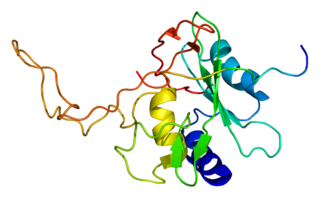
Suppressor of cytokine signaling 3 is a protein that in humans is encoded by the SOCS3 gene. This gene encodes a member of the STAT-induced STAT inhibitor (SSI), also known as suppressor of cytokine signaling (SOCS), family. SSI family members are cytokine-inducible negative regulators of cytokine signaling.

Suppressor of cytokine signaling 1 is a protein that in humans is encoded by the SOCS1 gene. SOCS1 orthologs have been identified in several mammals for which complete genome data are available.
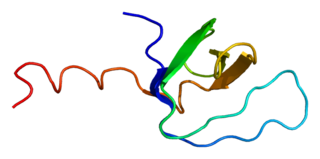
Tyrosine-protein kinase Tec is a tyrosine kinase that in humans is encoded by the TEC gene. Tec kinase is expressed in hematopoietic, liver, and kidney cells and plays an important role in T-helper cell processes. Tec kinase is the name-giving member of the Tec kinase family, a family of non-receptor protein-tyrosine kinases.

Cytokine-inducible SH2-containing protein is a protein that in humans is encoded by the CISH gene. CISH orthologs have been identified in most mammals with sequenced genomes. CISH controls T cell receptor (TCR) signaling, and variations of CISH with certain SNPs are associated with susceptibility to bacteremia, tuberculosis and malaria.

SH2B adapter protein 2 is a protein that in humans is encoded by the SH2B2 gene.

Suppressor of cytokine signaling 6 is a protein that in humans is encoded by the SOCS6 gene.
Interleukin-28 receptor is a type II cytokine receptor found largely in epithelial cells. It binds type 3 interferons, interleukin-28 A, Interleukin-28B, interleukin 29 and interferon lambda 4. It consists of an α chain and shares a common β subunit with the interleukin-10 receptor. Binding to the interleukin-28 receptor, which is restricted to select cell types, is important for fighting infection. Binding of the type 3 interferons to the receptor results in activation of the JAK/STAT signaling pathway.
A non-receptor tyrosine kinase (nRTK) is a cytosolic enzyme that is responsible for catalysing the transfer of a phosphate group from a nucleoside triphosphate donor, such as ATP, to tyrosine residues in proteins. Non-receptor tyrosine kinases are a subgroup of protein family tyrosine kinases, enzymes that can transfer the phosphate group from ATP to a tyrosine residue of a protein (phosphorylation). These enzymes regulate many cellular functions by switching on or switching off other enzymes in a cell.

Tyrosine phosphorylation is the addition of a phosphate (PO43−) group to the amino acid tyrosine on a protein. It is one of the main types of protein phosphorylation. This transfer is made possible through enzymes called tyrosine kinases. Tyrosine phosphorylation is a key step in signal transduction and the regulation of enzymatic activity.